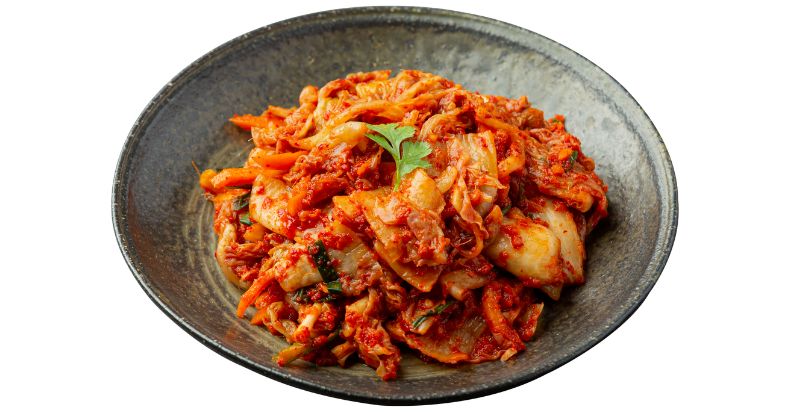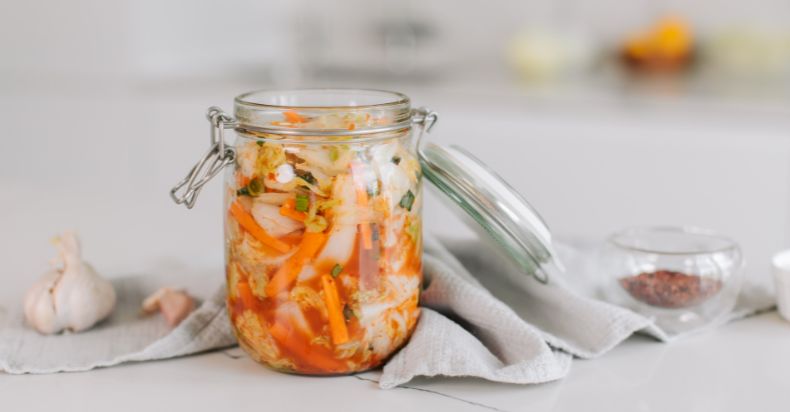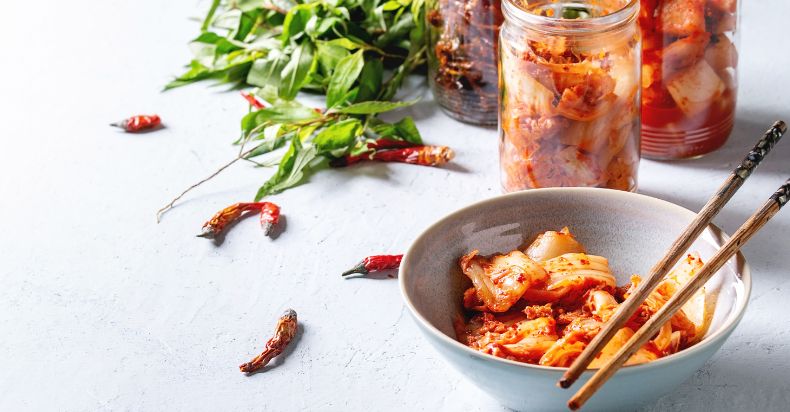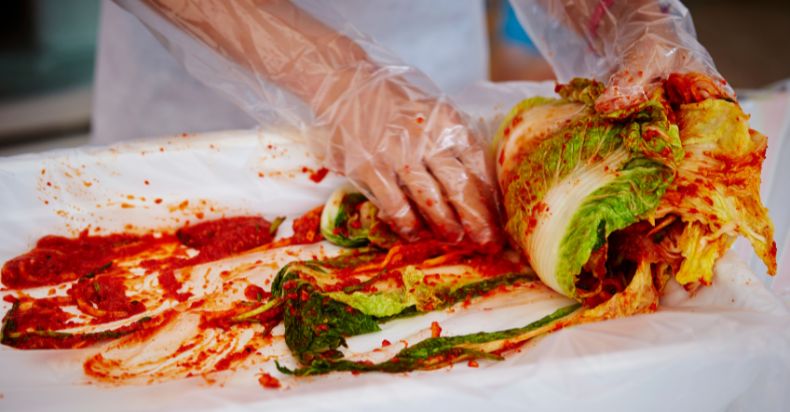Kimchi tastes like a complex blend of flavors that come together to create a unique taste experience. It's tangy from the fermentation process, spicy from the chili pepper flakes, salty from the salt used in fermenting, and rich in umami from the soy sauce. The crunchy texture of the vegetables adds another layer to the experience. Depending on the ingredients and fermentation time, the taste can vary from mild to intensely spicy, with over 200 known variations offering different flavor profiles.
What Is Kimchi?

Ever stumbled upon a dish that’s as mysterious as it is delicious? That’s kimchi for you! But what exactly is this tantalizing treat and what does it taste like?
Kimchi is a traditional Korean dish made of fermented vegetables, mainly napa cabbage and Korean radishes, mixed with a variety of seasonings. It’s like the ultimate food fusion, where flavors and textures unite to create a taste sensation.
The main ingredients of Kimchi are as follow:
- Napa Cabbage: The main star of the show, napa cabbage provides the crunchy base.
- Korean Radishes: These add a peppery kick and extra crunch.
- Chili Pepper Flakes: The source of the heat! This is where the spice comes in.
- Garlic and Ginger: These add depth and warmth to the flavor.
- Soy Sauce: This gives the dish its salty and umami taste.
- Other Add-ins: Some recipes include other goodies like scallions, carrots, or even fruit!
The process of making kimchi involves salting the vegetables and then fermenting them with the seasonings.
The result? A dish that’s tangy, spicy, salty, and a bit funky (in the best way possible!). It’s like a dance party in your mouth, and everyone’s invited! [source]
The History and Origin of Kimchi

Ready for a trip down memory lane? Kimchi has a rich history that dates back to the Three Kingdoms period, around 37 BCE. Let’s break it down:
- Ancient Times: Early versions of kimchi were simply salted vegetables. No spice yet, but still tasty!
- Introduction of Chili Peppers: In the 17th century, chili peppers were introduced to Korea, and kimchi got its signature heat. Talk about a game-changer!
- Cultural Significance: Kimchi is more than just food in Korea; it’s a part of the culture. There are even kimchi-making festivals and a museum dedicated to it!
- Modern Variations: Today, there are over 200 known varieties of kimchi. It’s like the Pokémon of food – gotta taste ’em all!
So, from ancient warriors to modern foodies, kimchi has been tantalizing taste buds for centuries. It’s not just a dish, it’s a culinary adventure that tells the story of a nation.
Ready to dive into the next section? Trust me; it’s going to be a tasty ride!
What Does Kimchi Taste Like? The Taste of Kimchi Explained

So, you’ve heard about kimchi, you know what it’s made of, but what does it actually taste like? If you’re expecting a simple answer, buckle up, because kimchi is anything but simple!
- Tangy: Thanks to the fermentation process, kimchi has a tangy, sour kick. It’s like a pickle, but with more attitude!
- Spicy: Those chili pepper flakes aren’t just for show; they bring the heat! It’s a spice that warms you from the inside out.
- Salty: The salt used in fermenting doesn’t just disappear; it sticks around to add a savory touch.
- Umami: That rich, deep flavor that you can’t quite put your finger on? That’s umami, and it’s all thanks to the soy sauce.
- Crunchy Texture: And let’s not forget the texture! The crunch of the vegetables adds another layer to the experience. It’s like a flavor party, and the crunch is the DJ!
But wait, there’s more! Kimchi isn’t a one-flavor-fits-all kind of dish. Depending on the ingredients and fermentation time, the taste can vary widely. Let’s explore:
- Mild Kimchi: Not a fan of spice? No problem! There’s mild kimchi that’s more tangy than hot. It’s like the chill cousin of the spicy version.
- White Kimchi: This version skips the chili flakes altogether, focusing on the refreshing and crisp flavors. Perfect for those “I can’t handle the heat” days!
- Aged Kimchi: The longer kimchi ferments, the more intense the flavors become. Aged kimchi is for the bold and the brave; it’s the roller coaster of the kimchi world!
- Seasonal Variations: Different seasons bring different ingredients, leading to unique flavors. Spring kimchi might be fresh and light, while winter kimchi could be hearty and robust.
So, what does kimchi taste like? It’s a symphony of flavors that dances on your tongue. From tangy to spicy, mild to wild, there’s a kimchi for every palate. It’s a dish that refuses to be put in a box, constantly surprising and delighting those who dare to taste.
Ready to learn how to enjoy kimchi like a pro? Stay tuned; the adventure is just getting started!
How to Enjoy Kimchi Like a Pro?
So, you’ve got your jar of kimchi, and you’re ready to dive in. But wait, what do you eat it with? Fear not, Kimchi is the ultimate team player!
- With Rice: The classic combo! Kimchi and rice are like the Batman and Robin of the culinary world. Simple, yet unbeatable.
- In Soups and Stews: Want to add a kick to your soup or stew? Throw in some kimchi! It’s like a flavor bomb that explodes with deliciousness.
- On Pizza or Burgers: Yes, you read that right! Kimchi on pizza or burgers adds a unique twist. It’s like putting a party hat on your meal.
- In Sandwiches and Wraps: Looking for a crunch in your sandwich? Add kimchi! It’s the crunchy gift that keeps on giving.
- As a Side Dish: Sometimes, kimchi likes to go solo, shining as a side dish. It’s the Beyoncé of the food world, after all!
Making Kimchi at Home

Feeling adventurous? Why not make kimchi at home? It’s like creating a culinary masterpiece in your kitchen. Here’s a simple guide:
- Choose Your Vegetables: Napa cabbage is the classic, but feel free to experiment!
- Salt and Rinse: Salt the veggies and let them sit, then rinse. It’s like giving them a spa day!
- Mix the Seasonings: This is where the magic happens. Mix chili flakes, garlic, ginger, and your choice of sauce.
- Combine and Ferment: Mix everything together and let it ferment. Patience is key; good things take time!
- Taste and Enjoy: Once it’s fermented to your liking, dig in! It’s a homemade flavor explosion.
Tips and Tricks:
- Start Small: If it’s your first time, try a small batch. Baby steps, my friend!
- Taste as You Go: Not sure about the spice level? Taste as you go and adjust as needed.
- Use Fresh Ingredients: Fresh is best! Your taste buds will thank you.
Whether you’re enjoying kimchi at a restaurant or making it at home, there’s no wrong way to eat this flavorful dish.
From classic pairings to adventurous combinations, kimchi is ready to spice up your culinary world. So grab a fork (or chopsticks) and dig in; the world of kimchi is waiting for you!
The Health Benefits of Kimchi
A Probiotic Powerhouse
Ever heard of probiotics? They’re the friendly bacteria that hang out in your gut and help with digestion.
Kimchi is packed with them! It’s like having a team of tiny helpers in your stomach.
- Digestive Aid: The probiotics in kimchi help with digestion. It’s like having a little massage for your insides!
- Boosts Immune System: These friendly bacteria also support your immune system. Think of them as your body’s personal cheerleading squad.
Rich in Vitamins and Minerals
Kimchi isn’t just a flavor bomb; it’s a nutrient bomb too! It’s like a multivitamin, but tastier.
Low in Calories, High in Fiber
Looking for a tasty treat that won’t break the calorie bank? Kimchi to the rescue!
- Low Calorie: Kimchi is low in calories but big on flavor. It’s like having your cake and eating it too (but spicier!).
- High Fiber: The crunchy vegetables in kimchi provide a good dose of fiber. It’s like a workout for your digestive system!
Potential Disease Fighter
Research is still ongoing, but some studies suggest that kimchi might have even more superpowers!
- Anti-Inflammatory: The spices in kimchi may have anti-inflammatory properties. It’s like a soothing balm for your body.
- Antioxidant Rich: Kimchi’s ingredients are full of antioxidants, which help fight off free radicals. It’s like having a superhero in your fridge!
So, what’s the verdict? Kimchi isn’t just a taste sensation; it’s a health sensation too! From aiding digestion to potentially fighting diseases, this flavorful dish is more than just a pretty plate.
Conclusion
In essence, kimchi tastes like a symphony of flavors that dances on your tongue, offering a taste that’s as multifaceted and rich as its history and cultural significance.
It’s a flavor adventure that’s both exciting and satisfying, inviting those who taste it to explore the world of Korean cuisine.
And there you have it, a complete guide to the tantalizing world of kimchi. From its taste to its preparation, its history to its health benefits, we’ve covered it all.
Now, armed with this knowledge, you’re ready to explore the world of kimchi on your own. Happy tasting!
FAQs
Can I make kimchi with other vegetables besides napa cabbage?
Absolutely! Feel free to experiment with other crunchy veggies like cucumbers or carrots.
It’s like a choose-your-own-adventure book, but tastier!
Is kimchi suitable for a gluten-free diet?
Most kimchi is gluten-free, but always check the label or ask if you’re eating out. Better safe than sorry!
How long does homemade kimchi last?
Homemade kimchi can last up to three months in the fridge. It’s the gift that keeps on giving!
Can I eat kimchi if I’m watching my sodium intake?
While kimchi does contain salt, you can enjoy it in moderation or look for low-sodium options. Balance is key!
What’s the best way to introduce kimchi to my kids?
Start with milder versions and pair it with familiar foods. It’s like easing into a hot bath – slowly but surely!
